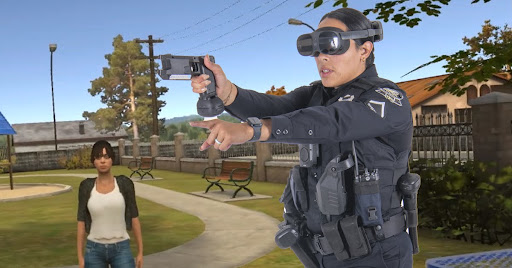Category: Public Safety04.11.2025

The public’s perception of law enforcement has always been dynamic. But while it’s easy for citizens to have conversations about where and how police training might be falling short, the more productive approach is to consider all the initiatives that are working well and building from there.
With so many improvements in agency policies and training formats over the years, there’s a lot to be proud of. Things like de-escalation and diversity training, along with situational awareness trials, all help officers to keep themselves and the public safe while respecting the rights of everyone.
With the integration of technologies like Virtual Reality (VR), agencies are now able to create much more immersive and engaging training formats that improve on these areas even more.
An important aspect of police training is knowing how to make life-or-death decisions when under high pressure. Sit-D training focuses on helping officers navigate their “fight or flight” response during dangerous engagements, keeping a clear head and making smarter choices.
Instead of simply acting on adrenaline, Sit-D training gives officers a helpful toolkit they can follow based on a proven 5-step thinking process when in tactical situations
De-escalation training is another important element of officer development that helps them to reduce the tension in certain situations while allowing them to resolve issues without having to resort to the use of force.
To provide officers with the right tools to achieve this, they are regularly trained on important communication strategies such as:
Helping officers to engage more meaningfully with their communities is another key element of training. This type of training focuses on helping officers recognize the sensitivities associated with their presence in certain situations.
Being able to notice and eliminate unconscious biases on the job helps officers avoid being put in compromising positions with the public while helping to better connect with the individuals they are sworn to protect.
As public safety challenges become more complicated, officer training also needs to evolve. Here are a couple of important reasons why:
When it comes to training officers in both tactical and non-tactical engagements, technology like VR has become a real game-changer. Below are some of the many benefits that adding this immersive technology to training formats provides:
Virtual reality (VR) training provides a highly immersive experience for officers, simulating common situations they may encounter in the field. It provides a 360-degree virtual environment that allows officers to interact with, rather than just watch, a training scenario.
These dynamic training environments incorporate real-world visuals and sounds, such as traffic noise, bystanders, or unfolding emergencies, which cannot be safely reproduced during live training exercises. This increased realism helps officers practice managing unfolding situations while providing them with practical ways to improve decision-making when under pressure.
One of VR’s biggest advantages is creating safer learning environments for officers, especially when going through high-risk training formats. Officers can be presented with scenarios like active shooters or hostage situations without any physical danger to themselves or others.
This eliminates many of the risks that can occur during live-action drills. Officers can freely experiment with different tactics and learn from their mistakes without facing any real-world consequences. This provides more opportunities to fail, which is an important learning lesson and helps to build more confidence when mastering certain skills.
VR training teaches officers to process multiple things at once, including verbal cues, body language, and certain environmental dangers. The system also provides instant feedback during training exercises to quickly help officers avoid developing certain habits.
For example, they can see how one command escalates a situation while another leads to a peaceful outcome. This practical, cause-and-effect experience is invaluable for developing sharp situational awareness and making better decisions when the pressure is on out in the field.
VR technology can be a smart investment for agencies that saves both time and money. Traditional role-playing training sessions can be expensive and often require renting out physical spaces, equipment, or additional staff to pose as actors, all of which VR eliminates.
Another major advantage of these solutions is their instant replayability. Officers can practice the same scenarios over and over until their responses become second nature. This combination of lower resource needs and more sustainable training formats makes virtual reality a much more scalable and affordable training solution for police departments.
Effective officer training isn’t just about choosing between live or digital training exercises. A blended approach can be a great way to add more diversity to training formats while leveraging the more immersive benefits that VR provides.
By combining proven methods like de-escalation with immersive virtual reality, departments can train officers who are better prepared for today’s more modern policing challenges.